Momofuku Ko
 Sunday, April 13, 2008 at 08:33PM
Sunday, April 13, 2008 at 08:33PM 
Note: This is a review of Momofuku Ko in its former location on First Avenue. In November 2014, the restaurant moved to 8 Extra Place.
*
The hassle of obtaining a reservation of Momofuku Ko has quickly become the stuff of legend—and that’s for a restaurant barely over a month old. After finally wrestling this bear to the ground, I can finally answer the question: Is it worth it?
Not that my opinion matters, because MoKo has MoJo (hat tip: The Pink Pig). If, by any chance, there were a negative review—and I haven’t seen one yet—it would hardly make a difference for the restaurant that seemingly can do no wrong. In this week’s New York, MoKo earns four stars from Adam Platt (conferred by the frothing critic after just one visit). At the Paper of Record, Frank Bruni is taking his time, but the smart money is betting on another four-star review.
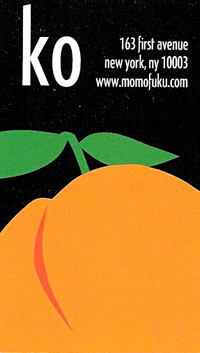 Irrelevant though our verdict may be, the short answer is: Yes, MoKo really does deserve all of that attention. And yes, if you care at all about food, it really is worth your while to jump through hoops to become one of the approximately 32 guests that are served six nights a week. (They are closed Tuesdays.)
Irrelevant though our verdict may be, the short answer is: Yes, MoKo really does deserve all of that attention. And yes, if you care at all about food, it really is worth your while to jump through hoops to become one of the approximately 32 guests that are served six nights a week. (They are closed Tuesdays.)
The ten-course tasting menu is not the best we’ve had in New York, but it is pretty darned close. And you get it for $85, which is at least $50 per person less than what you’d pay elsewhere for comparable quality. What you lose is the comfort and coddling that the better restaurants offer. You’re seated at a bar on wooden stools; those with back problems needn’t apply.
The chefs also serve the food, assisted by two servers who have to navigate a narrow space and sometimes can’t quite keep up with the demand. Peter Serpico, the restaurant’s executive chef, served most of our courses. He seemed to have very little enthusiasm for that part of the job. Two other chef–servers seemed more cheerful, but our sense was that the real joy for them is in the cooking.
Chef–owner (and media darling) David Chang was in the house. For about the first half of the meal, he was behind the counter doing mostly prep work, along with three other chefs. A photographer from Bloomberg news was snapping photos; everyone lightened up considerably after he left. Chang later disappeared, though we saw him again briefly before we left. There appeared to be two other employees behind the scenes, washing dishes and doing other prep work.
The two non-chef servers had an awful lot to do: greeting and seating guests; checking and returning coats; taking and delivering beverage orders; clearing plates (but not always); and setting silverware (but not always). Though the restaurant’s 14 seats were never completely full at any time during our meal, that is still a lot for two servers to do. Silverware didn’t always arrive when it should, and we detected some uncertainty among the staff about who was responsible for clearing plates.
Want a cappuccino after dinner? Sorry…they only have espresso.
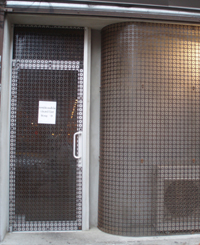
The entrance, unlabeled and easily missedI am not suggesting that service is bad here, but merely pointing out the gulf between Momofuku Ko and traditional three- and four-star restaurants. The service routine will improve with time, but MoKo will probably never offer the kind of pampering and coddling that many diners expect at this price level. It’s not an “occasion place,” but if future menus are as good as the one we had, I would happily go again. And again.
The beverage program is continuing to improve. There’s now a respectable wine list, with bottles as low as $32, as well as those in the hundreds. There is now a premium wine pairing at $85, in addition to the standard wine pairing at $50 that was available before. We ordered the premium wine pairing and were impressed with the choices, which included two sakes, a sparkling rosé, one red, and a number of whites.
Wine pairings are always a crap-shoot. At their best, you get provocative wines from producers off the beaten path—great wines that compelment the food, and that you never would have chosen yourself. At their worst, you get dull, generic wines that make you wish you’d just ordered a “blow-the-doors off” full bottle. The pairings at Ko are firmly in the first category. At $85, the wines are mostly young; you’re not getting anything like the 1962 Madeira we were served at Per Se. But it is still one of the more impressive wine pairings we’ve had, and well worth it.
In the restaurant’s early days, the menu is pretty much the same for everybody, but there are alternatives for most courses, to offer variety for second-time guests or to accommodate diners with dietary restrictions. We reported only one such restriction (my girlfriend doesn’t eat scallops) but we were served alternatives for four out of ten courses. By switching plates, we were able to sample fourteen dishes between us.
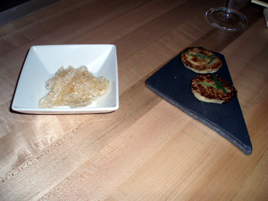
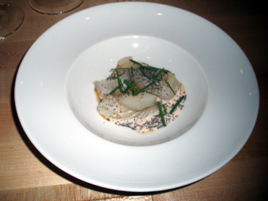
English muffin with pork fat and pork rinds (left); Fluke sashimi with spicy buttermilk & poppy seeds (right)
The first item—technically the amuse-bouche—was a miniature English muffin slathered in whipped pork fat, with dried pork rinds on the side. Some reviewers have raved about the muffins, but we weren’t quite as impressed. Chang has proved you can pair pork with anything; so what? The wine pairing was a sparkling rosé.
We adored the first savory course: Long Island fluke sashimi with spicy buttermilk and toasted poppy seeds. The cool, bracing freshness of the fluke worked perfectly with the spicy heat of the buttermilk. The wine pairing was a nice Chablis—and that comes from folks who aren’t Chablis fans.


Berkshire pork belly & oyster in kimchi broth (left); Louisiana crawfish in a Georgia pea soup (right)
The next course was split. I had the Berkshire pork belly with a Long Island oyster, Napa cabbage and kimchi consommé. You’ll never go wrong when David Chang serves pork (we saw him shucking the oysters), but I must confess I don’t quite get the fuss over the kimchi that many other critics have raved about.
My girlfriend had the Louisiana crawfish in a Georgia pea soup with crumpet mushrooms. The flavor contrast here might have even been better than the pork/oyster combo, but the crawfish should have been a little warmer. And it was probably just a goof, but we had to ask for spoons.
The wine pairing here was a sake.


Hen egg, caviar, potato chips (left); White asparagus, caviar, asparagus purée (right)
Another split course came next, again with white wine.
There’ve been snickers about “hen eggs” (anyone ever hear of a rooster egg?), but they can call it anything they want when it’s this good. A lightly smoked egg was supported here with hackleback caviar and candied lemon zest. At the edge of the plate, a pile of fingerling potato chips added very little to the effect.
We saw the chef lavishing plenty of attention over lovely white asparagus stalks, which were grilled, sauced with an asparagus purée and garnished with caviar. This bland and overly salty creation couldn’t compete with the intensity of the hen egg.
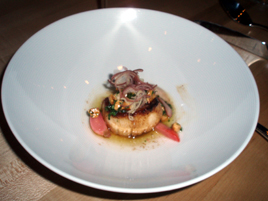

Scallop (left); Soft-shell crab (right)
While we were eating our caviar, we watched as the chef decapitated live soft-shell crabs and put them the frying pan, their legs still squirming. We did our best to ignore the crabs’ fate, but it wasn’t a sight for the squeamish.
This was another split course, with the crab served to me and the scallop to my girlfriend, even though she is the one who doesn’t eat scallops. The scallop was served with radishes, the crab with ramps, and both dishes had a other ingredients we couldn’t write down fast enough. The wine pairing was a Chardonnay.
The crab didn’t have much flavor, and it was also difficult to eat. Even though my girlfriend doesn’t eat scallops, I persuaded to try a bite, and she agreed it was the more enjoyable of the two.
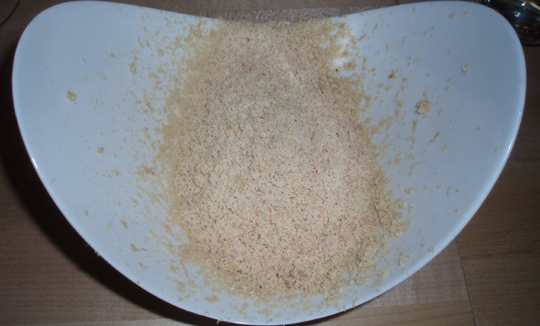
Shaved foie gras, lychee, pine nut brittle, riesling gelée
If MoKo has fired a “shot heard ’round the world,” it’s surely the dish that came next: shaved foie gras over lychee, pine nut brittle and a riesling gelée. The ingredients join in your mouth, leaving a startling sensation of the foie gras melting and melding with its unlikely companions.
The wine pairing was a sweet sake.
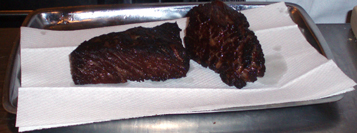
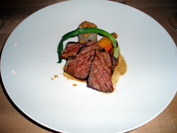
Deep-fried short rib as it came out of the fryer (left); and as served on the plate (right)
The deep-fried short ribs are almost as big a hit. They’re slowly braised overnight, then quickly finished in the deep fryer. The chef trims away the ends, a waste that we considered practically criminal, given how tender they are. I would happily eat a meal comprising nothing but the ends Momofuku is throwing away.
There’s also daikon radish and pickled mustard seed on the plate, but the short rib is the star. The wine pairing was our only red wine of the evening, a Cabernet Sauvignon.
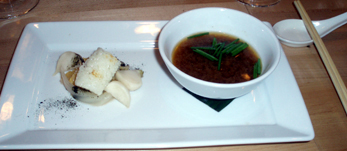

Miso soup with grilled rice (left); Lychee sorbet (right)
The last few courses weren’t quite as interesting. The last savory course was a miso soup with grilled rice and pickled vegetables. I believe the rice is slathered in more pork fat. The palate cleanser was a lychee sorbet over sesame crumble.

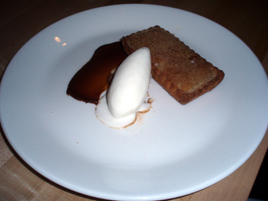
Cereal milk panna cotta (left); Deep-fried apple pie (right)
Everyone at MoKo seems to get one of two desserts, so we were pleased to be able to try both. The more interesting of the two is a cereal milk panna cotta with brittle chocolate and an avocado purée. The alternative was a deep-fried apple pie, which was just fine, but not all that far removed from the McDonalds version. On the whole, the desserts didn’t have the same level of invention as the savory courses.
There were no outright duds among the fourteen items we tasted. Setting aside the hype, there were several extraordinary dishes, a number of others that were merely good, and four or five that really ought to be better. A couple of dishes (the foie gras, the short ribs) have already gone platinum, and may be on the hit parade for a long time to come. The lesser stars will, I am sure, give way to new flights of Momofuku fancy.
Not since Per Se has a new restaurant been the subject of such over-heated attention. But sometimes places are hyped because they’re really worth it, and this is one of them. If you don’t mind hard, backless benches and occasionally inartful service, Momofuku Ko is just about everything it’s cracked up to be.
Momofuku Ko (163 First Avenue between 10th & 11th Streets, East Village)
Food: ★★★
Service: ★★
Ambiance: ★★
Overall: ★★★











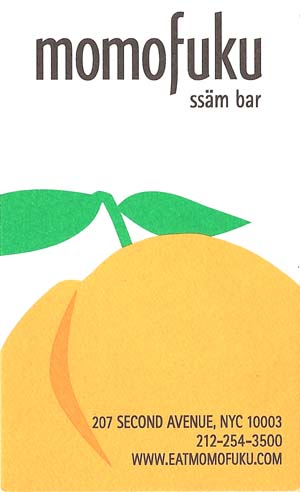

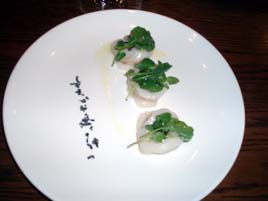
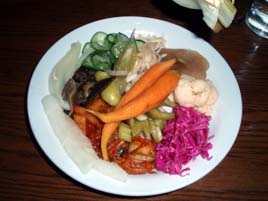
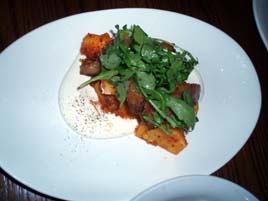

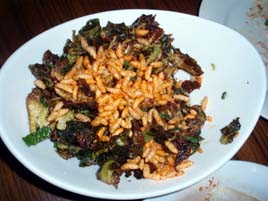
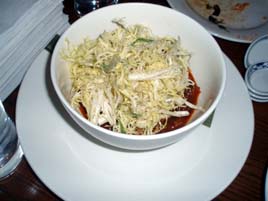


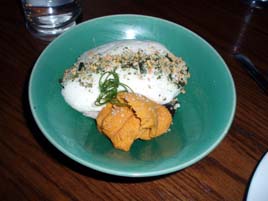
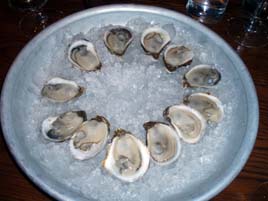
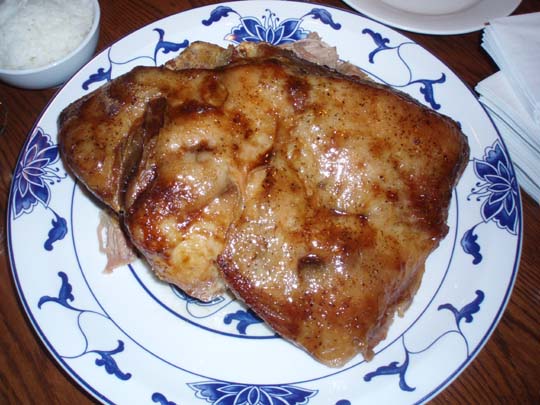



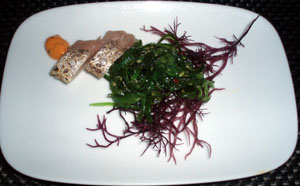

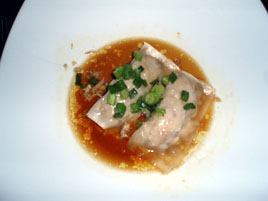
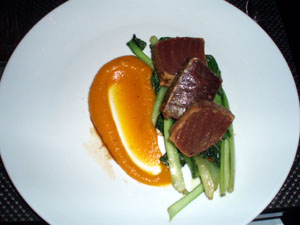

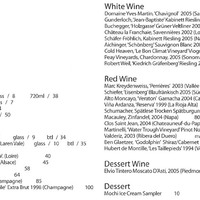

 Lower East Side newcomer
Lower East Side newcomer 







